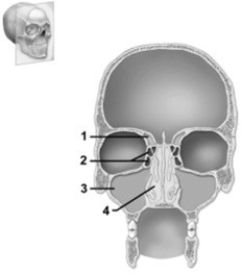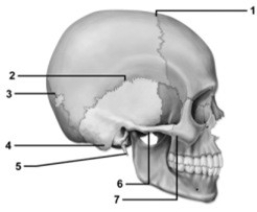A) Frontal
B) Sphenoid
C) Occipital
D) Parietal
E) Temporal
G) All of the above
Correct Answer

verified
Correct Answer
verified
Multiple Choice
 -This figure shows the scapula. Which number indicates the acromion?
-This figure shows the scapula. Which number indicates the acromion?
A) 1
B) 3
C) 4
D) 5
E) 7
G) B) and D)
Correct Answer

verified
Correct Answer
verified
Multiple Choice
Which cervical vertebra is also known as the vertebra prominens?
A) C1
B) C2
C) C4
D) C5
E) C7
G) All of the above
Correct Answer

verified
Correct Answer
verified
Essay
Describe the similarities between the skeletal structures of the upper and lower limbs.
Correct Answer

verified
Each limb is held in place by a girdle (...View Answer
Show Answer
Correct Answer
verified
View Answer
True/False
The ossa coxae are united anteriorly by the pubic symphysis and posteriorly by the sacrum.
B) False
Correct Answer

verified
Correct Answer
verified
True/False
The pelvic outlet is the space surrounded by the pelvic brim.
B) False
Correct Answer

verified
Correct Answer
verified
Multiple Choice
Which curves of the vertebral column are present at birth?
A) Thoracic and sacral
B) Lumbar and cervical
C) Lumbar and sacral
D) Cervical and thoracic
E) Lumbar and thoracic
G) B) and C)
Correct Answer

verified
Correct Answer
verified
Multiple Choice
 -This figure shows the thoracic cage. What vertebra is indicated by number 8?
-This figure shows the thoracic cage. What vertebra is indicated by number 8?
A) L1
B) L2
C) T1
D) T12
E) T10
G) A) and D)
Correct Answer

verified
Correct Answer
verified
True/False
Supraorbital margins with thick, rounded, blunt borders are characteristic of female skulls.
B) False
Correct Answer

verified
Correct Answer
verified
Multiple Choice
The incisive foramen and palatine process are features of which bone?
A) Mandible
B) Palatine bone
C) Vomer
D) Maxilla
E) Temporal bone
G) A) and E)
Correct Answer

verified
Correct Answer
verified
Multiple Choice
Which bone bears the superior and inferior temporal lines?
A) Temporal
B) Occipital
C) Parietal
D) Frontal
E) Zygomatic
G) B) and D)
Correct Answer

verified
Correct Answer
verified
Multiple Choice
Rami, trochanters, tubercles, and tuberosities are bone markings that serve as
A) articulating surfaces.
B) passageways for nerves.
C) attachments for ligaments or tendons.
D) pits or depressions to hold cartilage.
E) passageways for blood vessels.
G) A) and C)
Correct Answer

verified
Correct Answer
verified
Multiple Choice
The ________ of the scapula is the point where the medial and lateral borders meet.
A) lateral angle
B) superior angle
C) supraglenoid tubercle
D) infraglenoid tubercle
E) inferior angle
G) C) and D)
Correct Answer

verified
Correct Answer
verified
Multiple Choice
 -This figure shows the major cavities within the skull. Which number indicates the sphenoid sinus?
-This figure shows the major cavities within the skull. Which number indicates the sphenoid sinus?
A) 1
B) 2
C) 3
D) 4
E) The sphenoid sinus is not shown on this figure.
G) A) and B)
Correct Answer

verified
Correct Answer
verified
Multiple Choice
 -This figure shows the scapula. Which number indicates the superior angle?
-This figure shows the scapula. Which number indicates the superior angle?
A) 1
B) 2
C) 4
D) 7
E) 10
G) C) and D)
Correct Answer

verified
Correct Answer
verified
Multiple Choice
 -This figure shows a lateral view of the skull. Which number indicates the styloid process?
-This figure shows a lateral view of the skull. Which number indicates the styloid process?
A) 4
B) 5
C) 6
D) 7
E) The styloid process is not shown on this figure.
G) B) and C)
Correct Answer

verified
Correct Answer
verified
Multiple Choice
Protection of vital organs and hematopoiesis are two functions commonly named for the ________ skeleton.
A) axial
B) appendicular
D) undefined
Correct Answer

verified
Correct Answer
verified
Multiple Choice
Which bone bears the mandibular fossa?
A) Maxilla
B) Temporal
C) Zygomatic
D) Mandible
E) Frontal
G) B) and D)
Correct Answer

verified
Correct Answer
verified
Multiple Choice
The hyoid bone is located between the
A) mandible and the larynx.
B) maxilla and the mandible.
C) pharynx and the nasal cavity.
D) cranium and the axilla.
E) larynx and the trachea.
G) A) and B)
Correct Answer

verified
Correct Answer
verified
Short Answer
The palm of the hand is formed by the ________ bones.
Correct Answer

verified
Correct Answer
verified
Showing 181 - 200 of 203
Related Exams